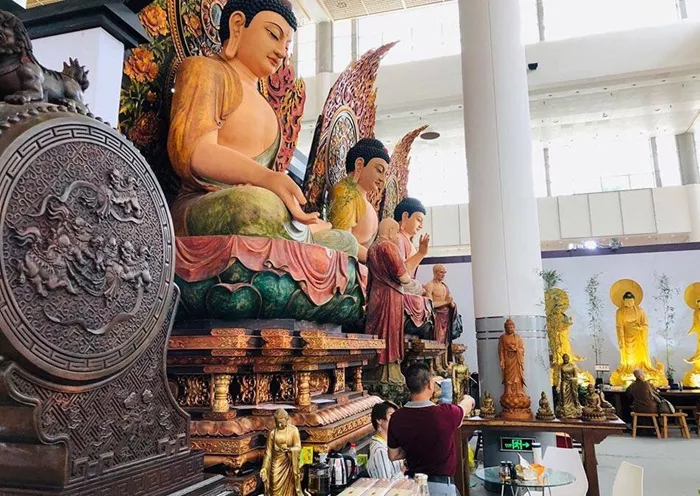Buddhist art is a rich and diverse form of expression that reflects the teachings, values, and cultural influences of Buddhism. Spanning over two millennia, it encompasses various mediums, including sculpture, painting, architecture, and ritual objects. This article provides an in-depth exploration of Buddhist art, its origins, key characteristics, and significance across different cultures and time periods.
Origins and Historical Development
Buddhist art originated in the Indian subcontinent following the life and teachings of Siddhartha Gautama, the Buddha, in the 5th to 4th centuries BCE. Initially, early Buddhist art was aniconic, avoiding direct representations of the Buddha. Instead, it used symbols like the lotus, wheel, and footprints to signify his presence and teachings.
Early Aniconic Period
During the early period, Buddhist art refrained from depicting the Buddha in human form. Instead, it employed symbolic representations:
- Lotus Flower: Symbolizes purity and spiritual awakening.
- Dharma Wheel (Dharmachakra): Represents the Buddha’s teachings.
- Footprints: Indicate the Buddha’s presence and path.
Introduction of Iconic Representations
The shift to iconic representations began around the 1st century CE, influenced by Greco-Roman art. This period saw the emergence of anthropomorphic images of the Buddha, particularly in the Gandhara and Mathura regions.
Gandhara Art
Gandhara art, a blend of Greek and Buddhist artistic elements, portrayed the Buddha with Hellenistic features such as wavy hair, realistic drapery, and serene expressions. This style played a crucial role in shaping Buddhist iconography.
Mathura Art
In contrast, Mathura art developed an indigenous style characterized by robust figures, elaborate halos, and symbolic gestures (mudras). This style emphasized spiritual energy and divine presence.
Key Characteristics of Buddhist Art
Buddhist art is distinguished by several key features that convey spiritual messages and teachings.
Symbolism
Symbolism is central to Buddhist art, with various elements representing different aspects of the Buddha’s teachings:
- Ushnisha: A cranial bump symbolizing wisdom.
- Urna: A dot on the forehead representing spiritual insight.
- Elongated Earlobes: Signify the Buddha’s renunciation of material wealth.
- Hand Gestures (Mudras): Each mudra conveys a specific teaching or moment in the Buddha’s life.
Use of Materials
Buddhist art utilizes a variety of materials, including stone, bronze, wood, and textiles. The choice of material often depends on regional availability and intended use. For instance, Thangka paintings, prominent in Tibetan Buddhism, are created on cotton or silk and used for meditation and teaching purposes.
Architectural Elements
Architecture plays a significant role in Buddhist art, with structures like stupas, temples, and monasteries serving both religious and artistic functions.
Stupas
Stupas are dome-shaped structures that house relics and symbolize the Buddha’s presence. They often feature a square base, a hemispherical dome, and a spire, representing the path to enlightenment.
Monasteries and Temples
Monasteries and temples serve as centers for worship, meditation, and learning. They are adorned with intricate carvings, murals, and statues that depict various aspects of Buddhist teachings.
Regional Variations of Buddhist Art
As Buddhism spread across Asia, it assimilated local artistic traditions, resulting in diverse regional styles.
Indian Subcontinent
India, the birthplace of Buddhism, boasts numerous significant Buddhist art sites:
- Sanchi: Known for its Great Stupa and intricately carved gateways.
- Ajanta Caves: Famous for their exquisite murals and rock-cut architecture.
- Karla Caves: Feature rock-cut chaitya halls and elaborate carvings.
Central Asia
Central Asia served as a conduit for the spread of Buddhist art along the Silk Road. The Mogao Caves in Dunhuang, China, contain a vast collection of murals and sculptures that reflect a fusion of Indian, Persian, and Chinese artistic influences.
East Asia
In East Asia, Buddhist art adapted to local aesthetics:
- China: Emphasized monumental sculptures and intricate cave temples.
- Japan: Developed unique styles like Zen ink paintings and wooden statues.
- Korea: Known for its elegant bronze Buddha statues and pagodas.
Tibet and the Himalayas
Tibetan Buddhist art is renowned for its vibrant colors and complex symbolism. Mandalas, thangkas, and ritual objects are integral to Vajrayana practices. The use of natural pigments and gold in thangka paintings adds to their spiritual significance.
Significance and Function of Buddhist Art
Buddhist art serves multiple purposes beyond aesthetic appreciation.
Didactic Tool
Artworks often depict scenes from the Buddha’s life, Jataka tales, and moral lessons, serving as educational tools for practitioners and laypeople.
Meditative Aid
Visual representations, such as mandalas and deity images, assist in meditation and visualization practices, helping practitioners focus and internalize teachings.
Ritual and Devotion
Art objects like statues, paintings, and ritual implements are used in ceremonies and devotional practices, fostering a connection between the practitioner and the divine.
Conclusion
Buddhist art is a profound expression of spiritual ideals, cultural exchange, and artistic innovation. Its evolution across regions and centuries reflects the adaptability and enduring relevance of Buddhist teachings. By studying and appreciating Buddhist art, one gains insight into the rich tapestry of human spirituality and creativity.

